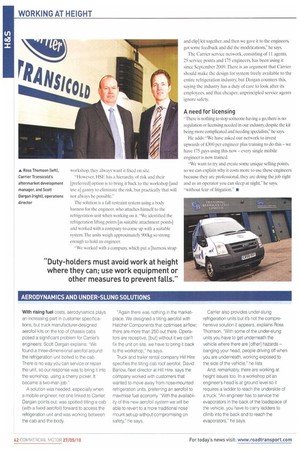Safety first
Page 40

Page 41

Page 42

If you've noticed an error in this article please click here to report it so we can fix it.
Solving working-at-height issues required Carrier Transicold to develop a fall restraint system that offers engineers and operators peace of mind.
Words: Kevin Swallow / Images: Tom Cunningham Health and safety, at its most basic, boils down to ensuring the well-being of your employees at all times.
To put it in basic financial terms, the costs for businesses can be hideous: the cost to settle a claim potentially runs into millions of pounds, not to mention fines from the Health and Safety Executive (HSE). That's to say nothing of the damage to your firm's reputation either.
Working at height is a problem for the road transport industry — the HSE states that working-at-height regulations apply to all work at height where there is a risk of a fall liable to cause personal injury, and you can seriously injure yourself just falling off a chair.
Risky business
From truck drivers falling out of cabs and off trailers, to service engineers working on ancillary equipment, many workers in road transport are at risk. Falls remain the biggest cause of workplace deaths and injuries, with 34 fatal falls in 2007/08, the latest year for which figures are available.
Responsibility falls to the employer, contractor, owner of the vehicle and the owner or tenant of the premises where an accident happened — basically anyone involved directly and indirectly. Each must prove they were not liable and took steps to ensure safety.
The HSE's advice is clear: "Duty-holders must avoid work at height where they can; use work equipment or other measures to prevent falls where they cannot avoid working at height; where they cannot eliminate the risk of fall, use work equipment or other measures to minimise the distance and consequences of a fall should one occur."
As such, Carrier Transicold UK found itself in the firing line, faced with a working at height problem for mobile engineers servicing refrigeration units fitted above the cabs on rigid trucks Traditional methods involved engineers stalking the catwalk on top of cabs to service the units without recognised safety measures in place.
Ross Thomson, aftermarket development manager for the refrigeration unit manufacturer and supplier, says the initial HSE focus was on drivers falling from cabs and trailers: "Carrier had a meeting with the HSE about what form of protection we offered.
"There wasn't anything ready made to pick off-theshelf for mobile engineers — so we developed a work positioning/fall restraint system. There was nothing in place before this."
No stability
Twenty years ago the cab would have been on steel suspension and relatively stable to walk on, today trucks are on air-sprung systems, which exaggerate movement when weight is transferred across the roof of the cab.
In addition, explains Scott Dargan, operations director, bodybuilders no longer Et catwalks to save cost. He adds: "Customers will not bring the vehicle back to the
THE SERVICE AGENT AND RESPONSIBILITY
North-west Carrier Transicold service agent CB Transport Refrigeration, based in Knowsley, Merseyside, provided the vehicles and equipment for the test. The company employs 24 people, including nine mobile engineers, two installation engineers, one workshop engineer and an apprentice. The company operates on the frontline making health and safety a fundamental issue for its engineers. Managing director Kevin Collins says three-quarters of the Carrier refrigeration unit work is done on customers sites, and one of the biggest problems for the firm is making sure customers know they are liable If anything goes wrong. We get asked for our risk assessment and we ask for theirs and we never get anything back," Collins explains. Carrier's Ross Thomson says: The bigger blue chip customers are starting to understand [exposure to liability] and starting to restrict what you can do on site, but because of the size of the Carrier network we have the support to bring a vehicle back to the workshop if we can't fix it on site." workshop, they always want it fixed on site.
"However, HSE has a hierarchy of risk and their [preferred] option is to bring it back to the workshop [and use a] gantry to eliminate the risk, but practically that will not always be possible."
The solution is a fall restraint system using a body harness for the engineer, who attaches himself to the refrigeration unit when working on it. "We identified the refrigeration lifting points [as suitable attachment points] and worked with a company to come up with a suitable systern.The units weigh approximately 900kg so strong enough to hold an engineer.
"We worked with a company, which put a [harness. strap and clip] kit together. and then we gave it to the engineers, got some feedback and did the modifications," he says.
The Carrier service network, consisting of 11 agents, 25 service points and 175 engineers, has been using it since September 2009. There is an argument that Carrier should make the design for system freely available to the entire refrigeration industry, but Dargan counters this, saying the industry has a duty of care to look after its employees, and that cheaper, unprincipled service agents ignore safety.
A need for Licensing -There is nothing to stop someone having a go, there is no regulation or licensing needed in our industry, despite the kit being more complicated and needing specialists," he says.
He adds: We have asked our network to invest upwards of £300 per engineer plus training to do this — we have 175 guys using this now — every single mobile engineer is now trained.
"We want to try and create some unique selling points, so we can explain why it costs more to use these engineers because they are professional, they are doing the job right and as an operator you can sleep at night," he says, "without fear of litigation." •
































































































































